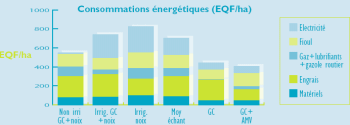Numerous studies show that energetically and on CO2, current agrofuels have a poor or even negative balance. By using this agricultural land to plant other perennial crops, the CO2 balance is further aggravated to the detriment of agrofuels.
By taking into account, not only CO2 and energy, but also all the inputs (fertilizer, electricity, heating, etc.) of a farm, it is possible to establish an EQF balance: equivalent of a liter of fuel oil per hectare cultivated. When more EQF per ha is needed than the agrofuel can produce, the only effect of agrofuels is to boost the profit of multinationals. However, few agrofuels give more energy than EQF than they consume. See the image below:

To find out more: the oil balance sheet of a farm, click here.
Even more serious is the influence of agrofuels on the stock market quotations of cereals and by capital extension: we are beginning to feel a coupling of “energy” cereals on the price of oil! This fact is hardly acceptable.
The tons of wheat or corn (origin of bioethanol) have doubled in a few months, making the situation of farmers in developing countries very critical. As if she wasn't already ...
According to Jean Ziegler: “It takes 232 kg of corn to fill up 50 L of bioethanol. With this quantity of corn, we feed a child for a year ".
We are in agreement on this fact, we are less so on the fact that, without agrofuel, this quantity of corn would arrive in the womb of this child! Malnutrition and famines are surely not due to the production of agrofuels, otherwise they would not have existed before… but it is certain that agrofuels using food plants will make things worse.
On the other hand, famines are often due to the exploitation of nearby natural resources: oil and gas in the lead. This should be taken into account in the global eco-balance sheet for petroleum… and even more so, and by comparison, in that of agrofuels, thus improving it… a little!
Current agrofuels, primarily bioethanol, are therefore very far from being a lasting and comprehensive solution to the energy problem.
However, there are fortunately other much more promising routes for agrofuels: the biofuels of 2th and 3th generation. These are generally techniques known for years (decades for some) so why are they not more developed? They would make it possible to really change the situation for these “new” fuels… without forgetting that the cleanest fuel is, of course, the one that we do not spend!

